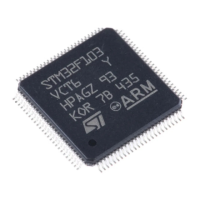UM0306 USB full speed device interface (USB)
431/519
be masked as ‘10’ (NAK) when a buffer conflict between the USB Peripheral and the
application software is detected (this condition is identified by DTOG and SW_BUF having
the same value, see Table 56 on page 430). The application software responds to the CTR
event notification by clearing the interrupt flag and starting any required handling of the
completed transaction. When the application packet buffer usage is over, the software
toggles the SW_BUF bit, writing ‘1’ to it, to notify the USB Peripheral about the availability of
that buffer. In this way, the number of NAKed transactions is limited only by the application
elaboration time of a transaction data: if the elaboration time is shorter than the time
required to complete a transaction on the USB bus, no re-transmissions due to flow control
will take place and the actual transfer rate will be limited only by the host PC.
The application software can always override the special flow control implemented for
double-buffered bulk endpoints, writing an explicit status different from ‘11’ (Valid) into the
STAT bit pair of the related register. In this case, the USB Peripheral will always use the
programmed endpoint status, regardless of the buffer usage condition.
18.5.4 Isochronous transfers
The USB standard supports full speed peripherals requiring a fixed and accurate data
production/consume frequency, defining this kind of traffic as ‘Isochronous’. Typical
examples of this data are: audio samples, compressed video streams, and in general any
sort of sampled data having strict requirements for the accuracy of delivered frequency.
When an endpoint is defined to be ‘isochronous’ during the enumeration phase, the host
allocates in the frame the required bandwidth and delivers exactly one IN or OUT packet
each frame, depending on endpoint direction. To limit the bandwidth requirements, no re-
transmission of failed transactions is possible for Isochronous traffic; this leads to the fact
that an isochronous transaction does not have a handshake phase and no ACK packet is
expected or sent after the data packet. For the same reason, Isochronous transfers do not
support data toggle sequencing and always use DATA0 PID to start any data packet.
The Isochronous behavior for an endpoint is selected by setting the EP_TYPE bits at ‘10’ in
its register; since there is no handshake phase the only legal values for the
STAT_RX/STAT_TX bit pairs are ‘00’ (Disabled) and ‘11’ (Valid), any other value will produce
results not compliant to USB standard. Isochronous endpoints implement double-buffering
to ease application software development, using both ‘transmission’ and ‘reception’ packet
memory areas to manage buffer swapping on each successful transaction in order to have
always a complete buffer to be used by the application, while the USB Peripheral fills the
other.
The memory buffer which is currently used by the USB Peripheral is defined by the DTOG
bit related to the endpoint direction (DTOG_RX for ‘reception’ isochronous endpoints,
DTOG_TX for ‘transmission’ isochronous endpoints, both in the related register) according
to Tabl e 57.
Table 57. Isochronous memory buffers usage
Endpoint
Type
DTOG bit
value
Packet buffer used by the
USB Peripheral
Packet buffer used by the
application software
IN
0
ADDRn_TX_0 / COUNTn_TX_0
buffer description table
locations.
ADDRn_TX_1 / COUNTn_TX_1
buffer description table
locations.
1
ADDRn_TX_1 / COUNTn_TX_1
buffer description table
locations.
ADDRn_TX_0 / COUNTn_TX_0
buffer description table
locations.

